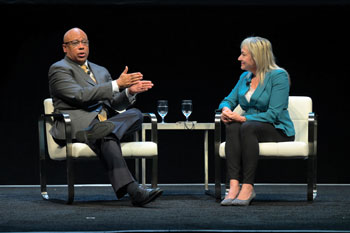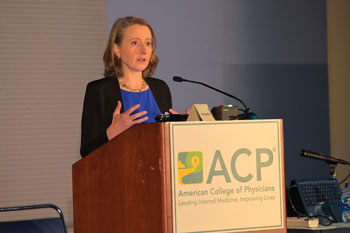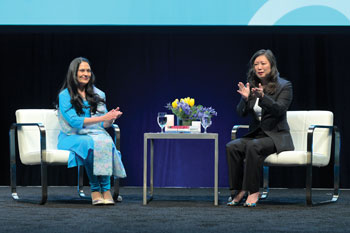Promoting diversity in medicine
An expert addressed medicine's limited diversity as the “health care crisis of our times” and offered potential solutions at Internal Medicine Meeting 2022.
Keynote speaker and interventional cardiologist Quinn Capers, MD, invited Internal Medicine Meeting 2022 attendees to put on their thinking caps during the Opening Ceremony.
He asked them to imagine a world where doctor-patient communication is uncomfortable and results in a chasm of mistrust. Where the most vulnerable, socioeconomically disadvantaged patient populations don't have enough doctors dedicated to their care. Where a patient's race or demographic influences the treatment plan, often to their detriment.

No imagination was necessary. “Welcome to our world—that's the world in which we live today,” said Dr. Capers. “But I know that the ACP and all of you are dedicated to doing something about it.”
During his keynote, he explained why medicine's limited diversity is the “health care crisis of our times” and offered potential solutions. But Dr. Capers, who is associate dean for faculty diversity, vice chair for diversity and inclusion, and the Rody P. Cox Professor in Internal Medicine at UT Southwestern in Dallas, also acknowledged that those trying to enhance diversity in medicine will occasionally encounter pushback. “It's important that you have an answer to the question ‘Why?’, because you will get that question.”
He provided five reasons for increasing diversity in medicine: 1) Physicians who train in diverse environments rate themselves as more comfortable treating minority patients, 2) Underrepresented minority physicians are more likely to serve the underserved, 3) Minority patients are more likely to follow the recommendations of minority physicians, 4) Diversity in the medical workforce would help reduce racial health care disparities, and 5) Diversity in research teams will enhance the impact of that research.
“Now hopefully you're armed with some information the next time you're challenged about why,” said Dr. Capers. The next question, he said, is why aren't we there yet?
That question led to another imagination exercise. “I'd like you to imagine that you're a kid and you want to be a doctor,” said Dr. Capers, who described this hypothetical child moving to a different apartment every three years while dealing with hunger, attending an underfunded and overcrowded school, and not participating in after-school programs due to unreliable family transportation.
“Those social determinants of health are also the social determinants of success, and we live in a society where everyone does not have an equal opportunity to even dream about being a physician,” he said. “We must all do something about it.”
To increase diversity, he said, internal medicine training programs can target three key areas: the deep pipeline of K-12 education, the intermediate pipeline of college students and medical students, and the endgame of selection processes in residency and beyond. But department chairs, division chiefs, and program directors need their presidents and boards of trustees to prioritize diversity, Dr. Capers said.
“Then every single training program can think of those three buckets … and work on all of them simultaneously and realize that they are all equally important,” he said.
Dr. Capers ended his talk by emphasizing the importance of diversity in medicine as part of global efforts to end systemic racism. “In response to the events of 2020, medical centers [and] medical organizations, ACP included, made bold antiracism statements. I think that's a good thing,” he said. “But I'm here to say the most powerful antiracist statement that we can make is to diversify our ranks.”
In a conversation with Dr. Capers after the keynote, ACP's Executive Vice President and Chief Executive Officer, Darilyn V. Moyer, MD, FACP, asked what individual internal medicine physicians, who represent 25% of practicing physicians in the U.S., can do to help increase diversity in medicine.
In practice, internal medicine physicians can ensure diversity is reflected in their office staff and the posters and photos on the walls, Dr. Capers said.
Also promote equity by considering the patient's experience, which may include extra roadblocks like paying for parking, he said. “I would say put yourselves in the role of the patient, and then walk around your practice and see what it is they see, what did they go through to get to you.”
On a personal level, internal medicine physicians can look into their own implicit biases and adopt strategies to reduce them, Dr. Capers said. They could also consider inspiring future doctors, perhaps by volunteering for a school career day, he added. “I guarantee you [if] you call your local high school and say, ‘I'm a doctor, and I'm interested in coming to talk to any of your students, maybe in a biology club, who think they want to be a doctor,’ you'll get a warm welcome.”
For Dr. Moyer, such encouragement from a female pediatrician while growing up in rural Pennsylvania led her down the path to becoming a first-generation physician. “She came to my bedside once [in the hospital] and said, ‘You know, Darilyn, you should think about being a physician. Women make great physicians, and we don't have enough of them,’” said Dr. Moyer, who is a fellow of the Royal College of Physicians (London), the Infectious Diseases Society of America, and the American Medical Women's Association.
In a similar fashion, Dr. Capers mentored a young man from fourth grade all the way to medical school. He encouraged internal medicine physicians to use their unique talents to enhance diversity in the profession.
“As we say, get in where you fit in,” he said. “If your talent is inspiring fourth graders, do that. … If your talent is thinking about selection processes, we need you. If your talent is in having college premed students shadow you, do that.”
Finally, in terms of what not to do, don't place blame on those affected by the structural inequities that they did not create, Dr. Moyer noted. “And we certainly don't expect them to fix it on their own,” she said. “So we really need the leadership to step up and, in conjunction with the grassroots movements, really synergize and work together to get this fixed for once and for all.”




